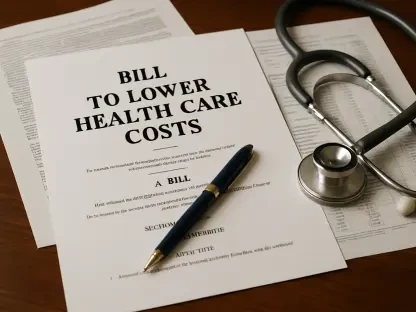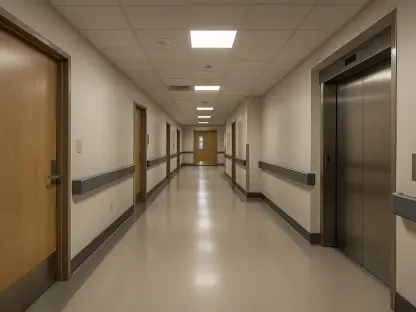The global respiratory care devices market stands at a pivotal moment, with projections indicating a remarkable climb from $26.40 billion in the current year to an astounding $45.13 billion by 2034, driven by a compound annual growth rate (CAGR) of 6.18%. This growth underscores a pressing need to address respiratory conditions affecting millions worldwide, such as chronic obstructive pulmonary disease (COPD), sleep apnea, and asthma. These devices, encompassing everything from ventilators to oxygen concentrators, are becoming indispensable in hospitals, homes, and clinics as the burden of respiratory ailments intensifies. Beyond the numbers lies a deeper story of innovation, accessibility, and evolving healthcare needs. As air pollution worsens and populations age, the demand for effective solutions has never been more urgent. This article delves into the forces propelling this market forward, the challenges that temper its progress, and the opportunities that could shape its future, offering a comprehensive look at a sector critical to global health.
Surging Market Growth and Key Insights
The trajectory of the respiratory care devices market paints a picture of robust expansion, with an estimated value of $26.40 billion this year, set to nearly double to $45.13 billion by 2034 at a steady CAGR of 6.18%. This significant increase reflects not just economic growth but a response to a mounting global health crisis. Respiratory diseases are on the rise, driven by factors like aging populations and environmental degradation, pushing healthcare systems to rely heavily on advanced equipment. The market spans a wide array of products, including therapeutic tools like nebulizers, monitoring systems such as pulse oximeters, diagnostic devices like spirometers, and essential accessories. Each category plays a unique role in addressing diverse patient needs across multiple care settings, highlighting the market’s broad relevance and adaptability.
Breaking down the drivers of this growth reveals a complex interplay of societal and technological factors. Rising air pollution levels in urban and industrial regions exacerbate respiratory conditions, creating a sustained demand for devices that can mitigate these effects. Simultaneously, advancements in medical technology are enhancing the effectiveness and accessibility of these tools, making them more integral to patient care. The market’s segmentation into therapeutic, monitoring, diagnostic, and accessory categories ensures that it caters to a spectrum of requirements, from acute hospital interventions to long-term home management. This diversity not only fuels growth but also positions the market as a cornerstone of modern healthcare solutions.
Escalating Burden of Respiratory Conditions
A primary catalyst for the market’s expansion is the staggering prevalence of respiratory diseases, which continue to affect millions globally and place immense pressure on healthcare infrastructure. COPD, identified as a leading cause of poor health by the World Health Organization, impacts approximately 392 million individuals worldwide, creating an urgent need for effective management tools. This condition, alongside asthma and other chronic ailments, drives demand for devices that can offer relief and improve quality of life. As diagnosis rates climb due to better awareness and access to medical services, the market for respiratory care solutions sees a corresponding surge, reflecting a critical intersection of health challenges and technological response.
Beyond COPD, conditions like sleep apnea are gaining attention as public knowledge grows, leading to increased testing and treatment needs. This trend is particularly evident in developed regions where healthcare access facilitates early detection, but it’s also emerging in less resourced areas as awareness spreads. Environmental factors, notably air pollution, compound these issues by aggravating existing conditions and contributing to new cases, especially in densely populated urban centers. The resulting health burden necessitates a robust supply of respiratory devices, from portable inhalers to sophisticated ventilators, ensuring that the market remains a vital lifeline for patients navigating these pervasive challenges.
Transition to Home-Based Healthcare Solutions
One of the most transformative shifts in the respiratory care landscape is the growing preference for home-based care, driven by patient desire for convenience and the need to alleviate pressure on hospital systems. This trend is reshaping how conditions like COPD and sleep apnea are managed, allowing individuals to monitor and treat their ailments without frequent clinical visits. Innovations such as portable oxygen concentrators and home sleep apnea testing devices are at the forefront of this change, offering practical solutions that enhance independence. Supported by endorsements from health authorities, these tools are becoming mainstream, signaling a broader move toward patient-centered care models.
The home care segment is projected to outpace other categories with a striking CAGR of 8.35% over the forecast period, reflecting its rising importance in the healthcare ecosystem. This rapid growth is fueled by technological advancements that make devices more user-friendly and cost-effective, alongside a societal push to reduce hospital readmissions. Elderly patients and those recovering from acute respiratory episodes, such as post-COVID-19 cases, particularly benefit from this shift, as it enables tailored care in familiar environments. The implications for manufacturers are significant, requiring a focus on designing compact, connected devices that meet the unique demands of home settings while maintaining clinical efficacy.
Technological Advancements Driving Innovation
Technology serves as the backbone of progress in the respiratory care devices market, introducing solutions that redefine patient outcomes and care delivery. Smart ventilators equipped with IoT connectivity and app-based controls exemplify this wave of innovation, providing real-time data and enhancing mobility for users. These developments are not mere conveniences but critical tools that allow clinicians to monitor patients remotely and adjust treatments promptly. With the monitoring devices segment expected to grow at a CAGR of 7.12%, the integration of cutting-edge technology is clearly a major growth driver, emphasizing precision and proactive management of respiratory conditions.
Artificial intelligence further amplifies this impact by enabling early detection of respiratory complications through advanced monitoring systems, a boon for both pediatric and geriatric populations. Additionally, innovations like solar-powered ventilators address practical challenges in off-grid or resource-limited areas, expanding the reach of respiratory care. These technological strides cater to a wide range of settings, from state-of-the-art hospitals to remote clinics, ensuring that solutions are as diverse as the needs they serve. The focus on wearable and connected devices also reflects a broader trend toward personalized healthcare, positioning technology as a bridge to better access and improved health outcomes across the globe.
Regional Disparities and Growth Opportunities
Geographically, the respiratory care devices market exhibits striking variations, with North America commanding a dominant 45.72% revenue share this year due to its advanced healthcare infrastructure and favorable policies. Supportive frameworks, such as reimbursement programs for home ventilation by the U.S. Centers for Medicare & Medicaid Services, bolster this leadership, ensuring widespread adoption of cutting-edge devices. The region’s emphasis on technological integration and robust funding for medical innovation creates an environment where respiratory care solutions can thrive, setting a benchmark for others to follow while addressing a significant portion of global demand.
In contrast, the Asia Pacific region emerges as the fastest-growing market, with a projected CAGR of 7.12%, driven by increasing awareness and supportive government initiatives. Policies in countries like India, aimed at boosting local manufacturing and affordability, are accelerating access to essential devices. Meanwhile, Europe focuses on sustainability, incorporating eco-friendly tools into its healthcare systems, while Latin America and the Middle East and Africa prioritize portability to tackle environmental and accessibility challenges. These regional dynamics illustrate a multifaceted market landscape, where tailored strategies are essential to capitalize on unique growth opportunities and address distinct health priorities.
Barriers of Cost and Access in Developing Regions
Despite the promising growth outlook, significant challenges loom, particularly around the cost of advanced respiratory devices, which often remain out of reach for many in low-income settings. The dramatic price spikes seen during the early stages of the COVID-19 pandemic, where ventilator costs doubled, highlight the financial strain on healthcare facilities with limited budgets. This barrier restricts market penetration in developing regions, where the need for respiratory care is often acute due to high disease prevalence and environmental stressors, yet resources to acquire sophisticated equipment are scarce, perpetuating health inequities.
Addressing accessibility goes hand in hand with cost concerns, as even when devices are available, distribution and infrastructure challenges can hinder their reach. Rural and underserved areas frequently lack the trained personnel or reliable power sources needed to operate advanced equipment, further limiting impact. Manufacturers and policymakers face the daunting task of developing affordable alternatives without compromising quality, alongside building systems to support deployment in challenging environments. Overcoming these hurdles is critical to ensuring that the benefits of market growth translate into tangible health improvements for all populations, not just those in affluent regions.
Sustainability as an Emerging Market Frontier
An exciting avenue for growth lies in the push for sustainability, with manufacturers increasingly focusing on devices that minimize environmental impact while maintaining clinical effectiveness. Innovations such as inhalers with eco-friendly propellants demonstrate how the industry can align with global environmental goals, reducing carbon footprints significantly compared to traditional models. This trend resonates with a growing consumer base that values green practices, offering companies a chance to differentiate themselves in a competitive market by prioritizing planetary health alongside patient care.
The emphasis on sustainability also influences procurement decisions, particularly in regions like Europe, where healthcare systems are adopting low-power and recyclable devices as part of broader green initiatives. This shift not only addresses environmental concerns but also opens up new market segments for forward-thinking manufacturers willing to invest in sustainable design. As regulatory frameworks evolve to encourage eco-conscious innovation, the integration of such principles into product development could become a defining factor in the market’s future, blending health benefits with a commitment to long-term ecological responsibility.
Competitive Landscape and Strategic Movements
The respiratory care devices market is characterized by a fragmented competitive landscape, where established giants and nimble startups vie for dominance through innovation and strategic positioning. Major players like Philips and ResMed lead with extensive portfolios and frequent product launches, often bolstered by acquisitions that expand their capabilities in diagnostics and treatment. These companies set industry standards by focusing on advanced technology and user comfort, ensuring they remain at the forefront of a rapidly evolving field while meeting diverse clinical and patient needs.
Emerging firms also play a vital role, introducing cost-effective solutions that challenge traditional pricing models, particularly in critical care applications. This dynamic environment fosters continuous improvement, with competition driving advancements in portability, connectivity, and affordability. Strategic partnerships and investments in research are common as companies seek to address unmet needs across various care settings. The result is a market that remains vibrant and responsive, constantly adapting to the shifting demands of healthcare providers and patients, ensuring that innovation remains a cornerstone of growth.
Looking Ahead to Future Possibilities
Reflecting on the journey of the respiratory care devices market, the path from a $26.40 billion valuation this year to a projected $45.13 billion by 2034 marks a period of significant strides and persistent challenges. The industry has witnessed robust expansion fueled by the rising prevalence of respiratory conditions, technological breakthroughs, and a notable shift toward home-based care. Regional differences, with North America’s dominance and Asia Pacific’s rapid ascent, paint a picture of varied yet interconnected growth narratives that shape global health responses.
Looking forward, stakeholders are encouraged to prioritize affordability and accessibility to bridge gaps in underserved regions, ensuring that innovations reach those most in need. Embracing sustainability emerges as a key strategy, with eco-friendly devices poised to redefine market standards. Additionally, leveraging digital health platforms for remote monitoring offers a pathway to enhance patient outcomes. These actionable steps, grounded in the lessons of past growth, set the stage for a future where respiratory care can balance clinical impact with broader societal and environmental considerations, driving meaningful progress.









